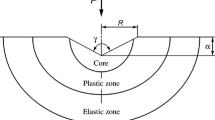Abstract
Advantages of applying high-temperature strain gages to carbon materials such as conglomerates of aluminum-reduction-cell cathodes and graphite for models of the cathodes or for nuclear reactors are shown. Tests on graphite and carbon conglomerate specimens, to which strain gages have been applied, are related. From these tests it is possible to obtain apparent strain, thermal hysteresis, drift, creep and mechanical hysteresis of strain gages. Test results for carbon specimens are compared with those of similar tests on stain-less-steel specimens with gages from the same lot.
Similar content being viewed by others
References
“Materiali Carboniosi per Blocchi Catodici Precotti,” Soc. Montecatini Edison (1968).
Cappa, P. and Santucci, G., “Calcolo del Campo di Temperatura in Modelli di Blocchi Catodici per Celle Elettrolitiche; Confronto con Risultati Sperimentali,” L'Ingegnere, 13–23 (June 1982).
Sulmont, B. and Hudault, G., “Application of a Thermoelectric Model to the Investigation of Reduction Cell Thermal Equilibrium,” Aluminum Pechiney — Saint Jean de Maurienne, France (1978).
Ajovalasit, A., Barbato, G., Bray, A. and Tschinke, M.F., “Raccomandazioni Sugli Estensimetri Elettrici a Resistenza,” VII Cong. Naz. AIAS, Cagliari (1979).
“Dehnungsmesstreifen mit Metallischem Messgitter, Kenngrössen und Prüfbedingungen,” VDI/VDE 2635, Verein Deutscher Ingegnieure, VDI/VDE — Fachgruppe Messtechnik, 4 Dusseldorf Graf-Recke-Strasse 84, West Germany (1974).
“Methods for Calibration of Bonded Electric Resistance Strain Gages,” BSI DD6, Brit. Stand. Inst., 2 Park Street, London W1A 2BS, England (1972).
“Strain-gages, Bonded Resistance,” NAS 942, Aero. Ind. Asso. of Amer., Inc., published by Nat. Stand. Asso., Inc., 1315 Fourteenth Street NW, Washington, DC (1964).
Steindler, R., Brutti, C. and Iaconis, F., “Metodo Estensimetrico per la Misura del Coefficiente di Dilatazione Termica Lineare,” Ingegneria, (5)–(6), (1983).
Nightingale, R.E., Yoshikawa, H.H. andLosty, H.H.W., “Nuclear Graphite,”Academic Press, London (1962).
Reynolds, W.N., “Physical Properties of Graphite,” Elsevier Publishing Co. Ltd. (1968).
Smithless, C.J., “Metals Reference Book,” Butterworths, London (1962).
Garofolo, F., “Temperature Dependences of the Elastic Modulus of Several Stainless Steels,”Proc. ASTM, (60),738 (1960).
“Metal Handbook,” IX Ed., ASM (1978).
Mantell, “Engineering Materials Handbook,” McGraw-Hill (1958).
“Caratteristiche dei catodi,” ALSAR S.p.A., Soc. Chimica Met. per l'Ind. dell' Alluminio in Sardegna, Tech. Note (1976).
“High Temperature Free Grid Strain Gauge LF 30,” Hottinger Bladwin Messtechnik GMBH, D 6100, Darmstad 1, Tech. Note (1981).
Author information
Authors and Affiliations
Rights and permissions
About this article
Cite this article
Steindler, R. High-temperature strain-gage behavior on carbon materials. Experimental Mechanics 28, 244–248 (1988). https://doi.org/10.1007/BF02329018
Received:
Accepted:
Issue Date:
DOI: https://doi.org/10.1007/BF02329018




